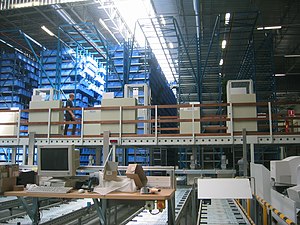
Image via Wikipedia
Like other functions of business warehousing and distribution have made some dramatic changes throughout the past century. What once began as a simple manual process of recording incoming inventory or production and outgoing orders has evolved into an automated system that records incoming and outgoing inventory using UPC codes at the time the transaction occurs.
This real time process allows every single piece of merchandise to be recorded on an ongoing basis thus allowing those in inventory management to know how much inventory they have at each precise moment. Unfortunately the process of automated warehousing and distribution is only as accurate as the system and those who operate it.
Is an automated system of warehousing and distribution as accurate as a manual system? We just mentioned that the system is only as accurate as those who operate it, so the key must be in the operator of the system. Actually, that is not correct—the system can have defaults.
For instance, have you ever been to a store that uses a scanner only to find the purchase you are attempting to make is not in their system? All of us have been through that at least once, but does the cashier go to a manager so they can put the product into the computer? NO! They enter a generic code to let it pass so you can pay for your purchases and leave. While this may be a quick solution to the problem, it does not allow for an accurate system of inventory management.
If the automated warehouse and distribution system is not accurate, does that mean it is not effective? While it may not be completely accurate, it is certainly better than the alternative: consistently maintaining inventory management through hand counting. With so many companies today warehousing and distribution processes would be greatly slowed if companies had to count every product remaining at the end of every working day. However, because of the margin of error with the automated systems of warehousing and distribution–even if through human error–there is a need to routinely perform hand counts of inventory on hand.
Is there a more effective way to achieve accuracy with automated warehousing and distribution? The best way to achieve accuracy with automated warehousing and distribution is to make certain all products have the correct codes on the packaging so that fulfillment center employees do not have to guess. The other essential part of the process is to make certain employees scan every product and do not scan products that are different just to let them pass through the system. These are two of the most common errors employees make that creates problems in an automated warehousing and distribution environment.

